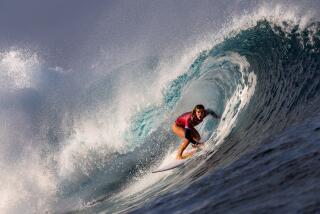Surf Meets the Turf : Huntington Inaugurates Walk of Fame With 6 Immortals
HUNTINGTON BEACH — Forsaking glitz and glamour, the Surfing Walk of Fame was inaugurated Thursday. It was hardly like the hoopla when a star is added to Hollywood’s Walk of Fame.
But then, this is Huntington Beach. And, these are legendary surfers, more known for attacking giant waves on surfboards than posturing before cameras and sipping mineral water with a spritz of lime.
After speeches by local dignitaries, the names of six immortal surfers, etched on small granite stones, were placed on the Main Street sidewalk near the city pier.
Filmmaker Bruce Brown, whose 1964 quest for the perfect wave, “Endless Summer,” introduced surfing to the masses, downplayed the praise bestowed on him, in very un-Hollywood-like fashion.
“I don’t really feel like I deserve this,” said Brown, 56, garbed in the beach uniform of a Hawaiian shirt, khaki trousers, and running shoes. “I’m flattered. But it’s kind of embarrassing. I’m more comfortable sitting at home talking to my friends.”
What did he plan to do after the ceremony?
“I’m going home to surf,” said Brown, whose “Endless Summer II” movie was recently released. “With the movie now out, I’m trying to get into shape by surfing.”
Master of Ceremonies Peter Townend, an Australian and 1976 world surfing champion who now lives in Orange County, introduced the four living inductees: Joyce Hoffman, a five-time world champion; Robert August, one of the stars of the original “Endless Summer”; Australian Mark Richards, a four-time world champion; and Brown.
Two surfing pioneers were inducted posthumously, Tom Blake, a Santa Monica surfer who invented the surfboard fin in 1935, and Duke Kahanamoku, former Olympic swimmer and actor who was known as the “father of surfing.”
“I never met Duke Kahanamoku,” Townend said. “But I feel I’m a product of what he started way back in 1915 in Australia when he introduced the sport. To me it’s an honor to talk about people like him.”
Kahanamoku was an automatic inductee for the city’s sidewalk. Born in Honolulu in 1890, the Duke, as he was known, became an inspiration to surfers of all ages. He helped start the first surf club in Oahu in 1907, and was voted sheriff of Honolulu 13 times.
Beside his contributions surfing, Kahanamoku also won five Olympic swimming medals and also had a stint in Hollywood with small parts in several films, including the 1948 “Wake of the Red Witch,” starring John Wayne.
When Kahanamoku died in 1968 of a heart attack, his funeral was the biggest Hawaii has seen.
For Hoffman, 47, of San Juan Capistrano, it was a day of pride.
“It’s nice to know that after 30 years, people remember you as giving something to surfing,” said Hoffman, who was accompanied by her daughter, Samantha, 18.
Hoffman is regarded by some as the best female surfing competitor ever. In 1965, she was named Los Angeles Times Woman of the Year, the only surfer to win the honor. In the ‘60s, she was unbeatable and won five U.S. championships and five world championships.
Ever the competitor, her daughter recalled hearing of her mother’s toughness on a trip to a Santa Cruz contest with rival Jericho Poppler. “Poppler won,” the daughter said, “and on the long drive home, my mother never said a word to her.”
Those outside of surfing may not have heard of Tom Blake. Blake died May 5, in Ashland, Wis., where he returned in the early 1980s after a career as a lifeguard and surf innovator in Hawaii and Southern California.
Inspired by Kahanamoku, Blake moved to the West Coast in 1921 at the age of 19 to take up surfing. He gained attention when he entered a surfing competition with a board in which he had drilled holes to reduce weight. He became a national distance-swimming champion for the Los Angeles Athletic Club and competed against Johnny Weissmuller, who went on to portray Tarzan in a series of films.
In 1930, he invented the first water housing used for surf photography. Five years later, after noticing a metal fin on the bottom of a boat, he decided to add a fin to a surfboard. The sturdy boards became so popular that lifeguards made them a standard piece of lifesaving equipment.
At Thursday’s ceremony, Blake’s biographer, Gary Lynch, read from a letter he received from Blake. “Nature equals God for all practical thinking. And that keeps us on the wave of life. . . . “
The inauguration went on after organizers agreed to pay $1,000 to the Hollywood Chamber of Commerce, which owns the trademark “Walk of Fame.” Under an agreement, Huntington Beach can use the name Surfing Walk of Fame for five years with an option to extend that time.
The idea for a walk of fame began in 1990, said Mike Abdelmuti and Ron Abdelfattah, co-owners of Jack’s Surfboards, who donated $30,000 to get the project started.
More to Read
Go beyond the scoreboard
Get the latest on L.A.'s teams in the daily Sports Report newsletter.
You may occasionally receive promotional content from the Los Angeles Times.










